WARNING: SPOILERS
Fiction is such a delicate thing. If one small element is missing, or is inconsistent with a previous small element, or doesn’t jibe with their experience of the world, the reader can immediately be taken out of the narrative with a loud mental THUNK. Stories are made up of a series of small elements; when you think about it, a novel must contain hundreds, if not thousands, of details that must work in harmony for the book as a whole to succeed. This is a large part of the reason why I believe that finishing a novel – of any genre and regardless of literary “quality” – that works within the parameters set up by the author is nothing short of a minor miracle.
The withdrawal of the reader’s suspension of disbelief because of problematic details in a narrative is unfortunate because most readers come to a novel looking to be entertained. They’re primed to enjoy the experience, happily suspending their disbelief from the first word; the audience is the writer’s to lose.
Airship Hunters, by Jim Beard and Duane Spurlock, lost me early on with the following passage: “Valiantine looked down at his civilian attire and fussed with it a bit, wondering for the hundredth time since he left his room over the extent of his ability to blend in with the locals. He’d chosen a plain brown suit with no ornamentation save for a straw hat and his watch and chain. He’d even eschewed spats for a solid pair of commonplace boots.” Why? Because, although a good description of the character’s clothes, the novel had given no description of the character himself. For the next few pages, I had an image in my head of a suit of clothes moving around without a human being in them, an image I’m sure the authors did not intend.
Small details. Huge importance.
It took a couple of chapters for me to get back into Airship Hunters, but I did because the story was intriguing. In post-Civil War America, military man Michael Valiantine is given the task of investigating sightings of strange, huge, impossible airships. Around the same time, Treasury Agent William Cabot is assigned a case of brutal murders, with bodies torn apart, because apparently counterfeit coins appeared at the crime scenes.Soon enough the two cases converge; Valiantine and Cabot are teamed up and given their own unit, called Aero Marshalls, to investigate these strange events.
The two authors are credited with writing alternate chapters, one told from Valiantine’s point of view, the other from Cabot’s. This could have been a recipe for disaster, with different writing styles clashing throughout the book; but, in fact, the chapters by the two authors are integrated very well, with a single authorial voice throughout the work.
At first, the characters seem somewhat cliched: Valiantine the grizzled military veteran and Cabot the hot-headed young investigator. However, there were occasional details that humanized and individuated the characters. Valiantine’s attention to detail, for example, struck me about halfway through the novel as being a form of OCD. Cabot’s reliance on investigative techniques taught to him by his mentor, Yankee Bligh (a real-life lawman), gave interesting insight into Cabot’s thoughts.
What really drew me back into Airship Hunters, though, were the bizarre details of the case. Appearances by the airships were often accompanied by the music of a full orchestra, for instance. Or, the murders appeared to be committed by eight foot tall monsters with the faces of human children. Or, the coins turned into metal blobs in police custody. Details like these made Airship Hunters feel like a steampunk X Files.
I also appreciated the fact that, although the novel is the first in a series, the authors took care to end this particular part of the story. The airship is destroyed, the antagonists dead (well, apparently, in any case), the case seems closed. To be sure, there are questions that suggest a much larger picture, such as where the people running the ship came from and why there seemed to be two factions of strangers working at cross-purposes. Still, the reader was given at least partial closure by the end of the novel, much like many episodes of the X Files, and can be satisfied with the book on its own.
Unfortunately, later chapters had problematic plot points that took me out of the novel again. The two heroes encounter President McKinley on a train, for example, but neither McKinley nor his retinue were described. This was a missed opportunity to paint a picture in my mind of what was happening; instead, I have only a vague vision of the scene.
Worse, in one scene the train has stopped on a bridge over a river, the airship hovering over it apparently intent on blowing it up. In the next scene, the train is chugging along the countryside, the airship gone. Now, although Valiantine had instructed the train conductor not to start it, I can buy that at some point between the scenes that order was countermanded and the train got going. However, the disappearance of the airship without destroying the train seems to me like a major plot hole: how did the train escape being blown up? A scene where the heroes fought off the airship seems to me necessary to answer this question.
Clearly, Airship Hunters is not perfect. Still, large parts of it are entertaining, so, if you like the genre, you may find it worth your time.











Recent Comments